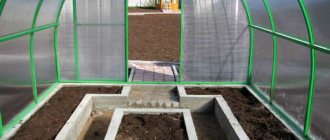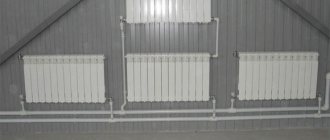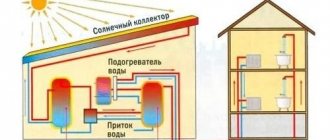Rising energy prices make us think about the possibility of providing ourselves with them ourselves. One option is a biogas plant. With its help, biogas is obtained from manure, droppings and plant residues, which, after purification, can be used for gas appliances (stoves, boilers), pumped into cylinders and used as fuel for cars or electric generators. In general, processing manure into biogas can meet all the energy needs of a home or farm.
Construction of a biogas plant is a way to independently provide energy resources
What it is
The composition of biogas is similar to natural gas produced on an industrial scale. Stages of biogas production:
- A bioreactor is a container in which biological mass is processed by anaerobic bacteria in a vacuum.
- After some time, a gas is released consisting of methane, carbon dioxide, hydrogen sulfide and other gaseous substances.
- This gas is purified and removed from the reactor.
- Recycled biomass is an excellent fertilizer that is removed from the reactor to enrich fields.
Producing biogas with your own hands at home is possible provided that you live in a village and have access to animal waste. It is a good fuel option for livestock farms and agricultural enterprises.
The advantage of biogas is that it reduces methane emissions and provides an alternative energy source. As a result of biomass processing, fertilizer is formed for vegetable gardens and fields, which is an additional advantage.
To make your own biogas, you need to build a bioreactor to process manure, bird droppings and other organic waste. The raw materials used are:
- wastewater;
- straw;
- grass;
- river silt
Using straw to produce biogas
It is important to prevent chemical impurities from entering the reactor, as they interfere with the processing process.
Use Cases
Processing manure into biogas makes it possible to obtain electrical, thermal and mechanical energy. This fuel is used on an industrial scale or in private homes. It is used for:
- heating;
- lighting;
- heating water;
- operation of internal combustion engines.
Using a bioreactor, you can create your own energy base to power your private home or agricultural production.
Thermal power plants using biogas are an alternative way to heat a private farm or small village. Organic waste can be converted into electricity, which is much cheaper than running it to the site and paying utility bills. Biogas can be used for cooking on gas stoves. The great advantage of biofuel is that it is an inexhaustible, renewable source of energy.
Connecting and starting the internal combustion engine
Since the calorific value of fuel generated from firewood is much lower than that of gasoline, the air/fuel ratio must be changed for normal engine operation. To do this, you will have to make a mixer and place it on the intake tract. The simplest type of mixer is an air damper controlled by a draft from the passenger compartment.
Starting a cold engine on wood is quite a task. Therefore, you should not completely abandon gasoline, but supply it only during startup, and then switch to fuel produced by gas. To implement switching to different types of fuel, make a mixer according to the scheme proposed in the book by I. S. Mezin “Transport gas generators”:
Note. In this book you will find a lot of useful information regarding the production of gaseous fuels from various types of wood and coal.
Now about the features of starting and operating internal combustion engines on wood and coal:
- the size of firewood loaded into the bunker should not exceed 6 cm;
- raw wood cannot be used, since all the heat generated will be used to evaporate water and the pyrolysis process will be extremely sluggish;
- ignition is carried out through a special hole with a check valve with the fan turned on no later than 20 minutes before the trip;
- engine power is reduced by about 50% compared to driving on gasoline;
- It follows from the previous paragraph that the service life of the engine on homemade fuel is also reduced.
It is noteworthy that after short-term parking, the car starts easily from the gas engine, without switching to gasoline. After a long period of inactivity, it will take 5-10 minutes to re-ignite the unit. How to start a car engine from a homemade wood-burning gas generator, see the following video:
Biofuel efficiency
Biogas from litter and manure is colorless and odorless. It provides the same amount of heat as natural gas. One cubic meter of biogas provides the same amount of energy as 1.5 kg of coal.
Most often, farms do not dispose of waste from livestock, but store it in one area. As a result, methane is released into the atmosphere, and manure loses its properties as a fertilizer. Timely processed waste will bring much more benefits to the farm.
It is easy to calculate the efficiency of manure disposal in this way. The average cow produces 30-40 kg of manure per day. This mass produces 1.5 cubic meters of gas. From this amount, 3 kW/h of electricity is generated.
How to build a biomaterial reactor
Bioreactors are concrete containers with holes for the removal of raw materials. Before construction, you need to choose a location on the site. The size of the reactor depends on the amount of biomass you have daily. It should fill the container 2/3 full.
If there is little biomass, instead of a concrete container, you can take an iron barrel, for example, an ordinary barrel. But it must be strong, with high-quality welds.
The amount of gas produced directly depends on the volume of raw materials. In a small container you will get a little of it. To get 100 cubic meters of biogas, you need to process a ton of biological mass.
To increase the strength of the installation, it is usually buried in the ground. The reactor must have an inlet pipe for loading biomass and an outlet for removing waste material. There should be a hole at the top of the tank through which biogas is discharged. It is better to close it with a water seal.
For a correct reaction, the container must be hermetically sealed, without air access. The water seal will ensure timely removal of gases, which will prevent the system from exploding.
Main advantages
There are many advantages to using biogas.
- Low cost, today it costs about the same as gasoline, but at the same time it is much cleaner, which allows you to significantly save on maintenance of boilers running on this fuel.
- You will not depend on oil, which, as you know, is not available in all countries.
- The source from which biofuels are extracted is renewable, unlike gasoline. Oil is not infinite; sooner or later it will run out, but the listed materials necessary for the production of biological fuel will always be there.
- The amount of harmful gases released into the atmosphere is reduced. If you give figures, this is approximately 65% of the difference.
Reactor for a large farm
A simple bioreactor design is suitable for small farms with 1-2 animals. If you own a farm, it is best to install an industrial reactor that can handle large volumes of fuel. It is best to involve special companies involved in developing the project and installing the system.
Membrane bioreactor
Industrial complexes consist of:
- Interim storage tanks;
- Mixing installations;
- Bioreactor;
- A small thermal power plant that provides energy for heating buildings and greenhouses, as well as electricity;
- Containers for fermented manure used as fertilizer.
The most effective option is to build one complex for several neighboring farms. The more biomaterial is processed, the more energy is produced as a result.
Before receiving biogas, industrial installations must be approved by the sanitary and epidemiological station, fire and gas inspection. They are documented; there are special standards for the location of all elements.
Making gasgen for a car
Before making a working gas generator for a car, we suggest that you familiarize yourself with some recommendations:
- Organizing the supply of power gas in a modern car with an injector is not an easy task. You will have to change the controller settings (firmware), otherwise the wood fuel motor will not work. You need a car with an old fuel supply system - a carburetor.
- The greater the power and displacement of the engine, the higher the performance of the gas generator. Accordingly, it will grow in size.
- To fit the installation into the trunk of a passenger car, you will need to cut out part of the bottom. If you do not want to touch the body, then immediately plan to install a wood-burning generator with filters and a cooler on the trailer.
- To make a gasification chamber where the temperature exceeds 1000 °C, use low-carbon thick steel (4-5 mm).
- To reduce the resin content in the gas mixture, make a chamber with a neck, as shown in the drawing.
Important point. You should not increase the diameter of the gasification chamber (in the drawing it is 340 mm) in order to achieve greater productivity. The increase will be negligible, and the quality of wood processing will deteriorate. But it is not necessary to maintain a height of 183 cm, unless you place the unit on a trailer or on a truck frame. The fuel hopper and ash pan can be shortened.
To assemble the inside of a car gas generator (bunker), an old propane cylinder, a receiver from a KamAZ truck, or a thick-walled pipe will do. Considering that the diameter of the steel vessel is 300 mm, the remaining dimensions must be proportionally reduced. The exception is the gasification chamber, its minimum diameter is 140 mm. The casing and cover of the generator will use metal 1.5 mm thick. The latter is sealed with graphite-asbestos cord.
How to calculate reactor volume
The volume of the reactor depends on the amount of waste generated daily. Remember that the container only needs to be 2/3 full for effective fermentation. Also consider fermentation time, temperature and type of raw material.
It is best to dilute manure with water before sending it to the digester. It will take about 2 weeks to process manure at a temperature of 35-40 degrees. To calculate the volume, determine the initial volume of waste with water and add 25-30%. The volume of biomass should be the same every two weeks.
Location determination
To minimize the costs of organizing the process, it makes sense to locate the biogas plant close to the source of waste - near buildings where poultry or animals are kept. It is advisable to develop the design so that loading occurs by gravity. From a barn or pigsty, you can lay a pipeline at a slope through which manure will flow by gravity into the bunker. This greatly simplifies the task of maintaining the reactor, and also removing manure.
It is most advisable to locate the biogas plant so that waste from the farm can flow by gravity
Typically, buildings with animals are located at some distance from a residential building. Therefore, the generated gas will need to be transferred to consumers. But laying one gas pipe is cheaper and easier than organizing a line for transporting and loading manure.
How to ensure biomass activity
For proper fermentation of biomass, it is best to heat the mixture. In the southern regions, the air temperature promotes the onset of fermentation. If you live in the north or in the middle zone, you can connect additional heating elements.
To start the process, a temperature of 38 degrees is required. There are several ways to ensure this:
- A coil under the reactor connected to the heating system;
- Heating elements inside the container;
- Direct heating of the container with electric heating devices.
The biological mass already contains bacteria that are needed to produce biogas. They wake up and begin activity when the air temperature rises.
It is best to heat them with automatic heating systems. They turn on when cold mass enters the reactor and automatically turn off when the temperature reaches the desired value. Such systems are installed in water heating boilers; they can be purchased at gas equipment stores.
If you provide heating to 30-40 degrees, then processing will take 12-30 days. It depends on the composition and volume of the mass. When heated to 50 degrees, bacterial activity increases, and processing takes 3-7 days. The disadvantage of such installations is the high cost of maintaining high temperatures. They are comparable to the amount of fuel received, so the system becomes ineffective.
Another way to activate anaerobic bacteria is by stirring the biomass. You can install the shafts in the boiler yourself and move the handle out to stir the mass if necessary. But it is much more convenient to design an automatic system that will mix the mass without your participation.
How a gas pipeline is built (connecting a gas line to a house)
With an approved project, you must contact a company that deals with similar work (necessarily with a state license). If the estimate drawn up by the company suits both parties, then an agreement is concluded to carry out the relevant work.
The contract must indicate that the final payment will be made only after all work has been completed and accepted by the official commission.
Upon completion of installation work, as-built production and technical documentation is drawn up, which must be approved by the commission. After successfully connecting the gas line to the house, you can immediately conclude an agreement for the installation of the equipment that will be connected (boiler, stove, etc.).
Commissioning work should be carried out exclusively by gas specialists Source gasworld.ru
Correct gas removal
Biogas from the manure is removed through the top cover of the reactor. It must be tightly closed during the fermentation process. Typically a water seal is used. It controls the pressure in the system; when it increases, the lid rises and the release valve is activated. A weight is used as a counterweight. At the outlet, the gas is purified with water and flows further through the tubes. Purification with water is necessary to remove water vapor from the gas, otherwise it will not burn.
Before biogas can be processed into energy, it must be accumulated. It should be stored in a gas tank:
- It is made in the shape of a dome and installed at the outlet of the reactor.
- Most often it is made of iron and coated with several layers of paint to prevent corrosion.
- In industrial complexes, the gas tank is a separate tank.
Another option for making a gas holder: use a PVC bag. This elastic material stretches as the bag fills. If necessary, it can store large quantities of biogas.
Mixing devices
In order for the biogas plant to operate normally, it is necessary to regularly mix the liquid in the bioreactor. This simple process solves many problems:
- mixes a fresh portion of the load with a colony of bacteria;
- promotes the release of produced gas;
- equalizes the temperature of the liquid, excluding warmer and colder areas;
- maintains the homogeneity of the substrate, preventing the settling or floating of some components.
Typically, a small homemade biogas plant has mechanical agitators that are driven by muscle power. In large-volume systems, the agitators can be driven by motors that are activated by a timer.
Types of stirrers for bioreactors
The second method is to stir the liquid by passing some of the generated gas through it. To do this, after exiting the metatank, a tee is installed and part of the gas flows into the lower part of the reactor, where it exits through a tube with holes. This part of the gas cannot be considered a consumption, since it still enters the system again and, as a result, ends up in the gas tank.
The third method of mixing is to use fecal pumps to pump the substrate from the lower part and pour it at the top. The disadvantage of this method is its dependence on the availability of electricity.
Underground biofuel production plant
To save space, it is best to build underground installations. This is the easiest way to get biogas at home. To set up an underground bioreactor, you need to dig a hole and fill its walls and bottom with reinforced concrete.
Holes are made on both sides of the container for the inlet and outlet pipes. Moreover, the outlet pipe should be located at the base of the container for pumping out the waste mass. Its diameter is 7-10 cm. The entrance hole with a diameter of 25-30 cm is best located in the upper part.
Biofuel underground installation
The installation is covered with brickwork on top and a gas tank is installed to receive biogas. At the outlet of the container you need to make a valve to regulate the pressure.
A biogas plant can be buried in the yard of a private house and sewage and livestock waste can be connected to it. Recycling reactors can completely cover a family's electricity and heating needs. An additional benefit is getting fertilizer for your garden.
A DIY bioreactor is a way to get energy from pasture and make money from manure. It reduces farm energy costs and increases profitability. You can do it yourself or order installation. The price depends on the volume, starting from 7,000 rubles.











